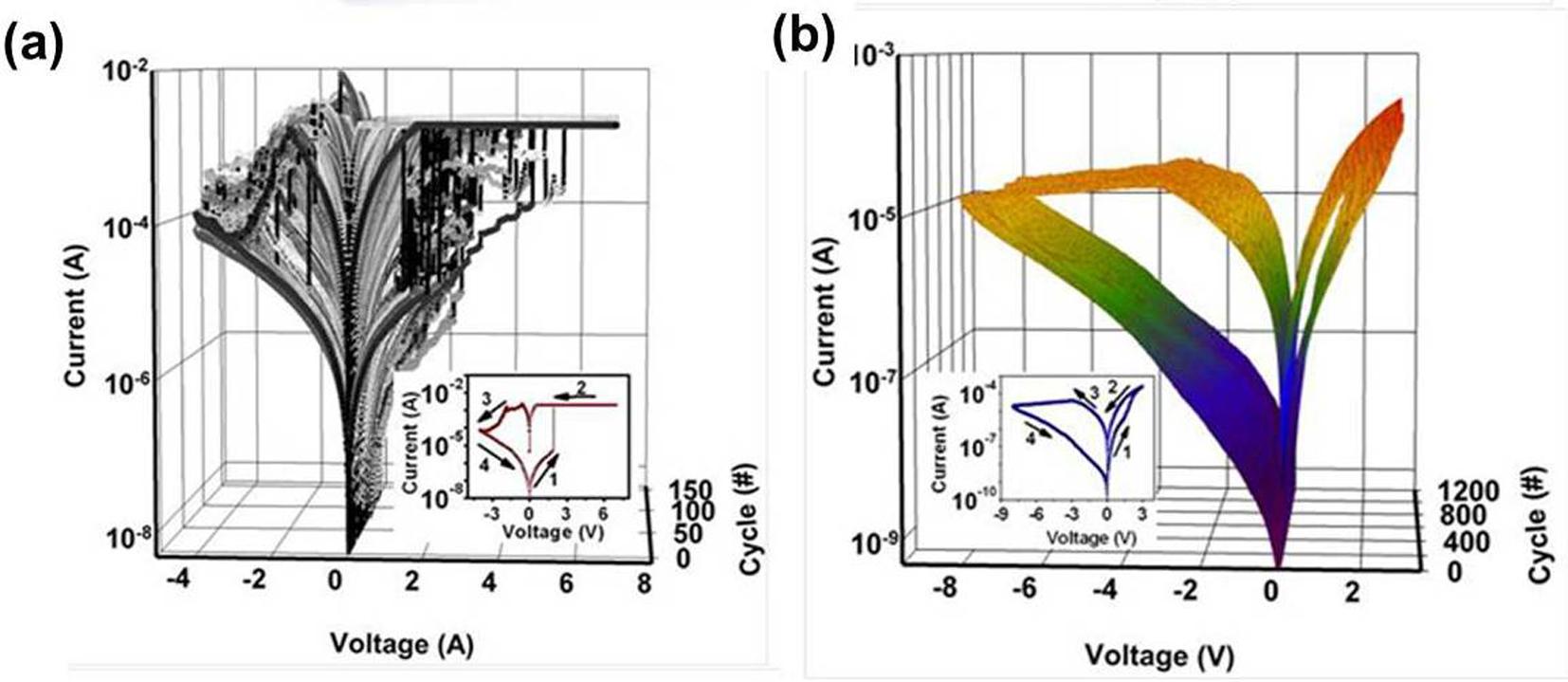Resistive Random Access Memory (RRAM) is a novel non-volatile memory device with a metal/insulator (or semiconductor)/metal (MIM) sandwiched structure. Based on the concept of resistive switching (RS), where the dielectric layer suddenly changes its resistance under the stimulation of an external electric field, RRAM stores digital data in a manner completely different from that of the conventional Si-based devices.
With its attractive metrics including low power consumption, high programming speed, long-term endurance, mass-storage capability, simple device structure, good scaling potential and excellent compatibility with CMOS technology, RRAM has been identified as one of the promising candidates for the next-generation data storage applications. Organic/polymeric materials have also attracted numerous amount of attention in RRAM exploration, due to its additional advantages of solution and large-area processability, mechanical flexibility, light-weight and low-fabrication-cost potentials.
Recently, the magnetoelectronic materials and devices (MEMT) team, led by Prof. Run-Wei Li, from the Ningbo Institute of Materials Technology & Engineering (NIMTE), Chinese Academy of Sciences (CAS), has established a series of remarkable progresses in the area of organic/polymeric RRAMs. Prof. Li and his group observed stable resistive switching phenomena in a new polyimide material bearing 9-phenyl-9H-carbazole pendant unities, and identified the electron donor-acceptor (D-A) charge transfer interaction mechanism of the RS effect in this new polyimide by in-situ conducting atomic force microscopy (CAFM) technique.
In collaboration with Prof. Jing Lu from the Peking University and Prof. Wenge Zheng from NIMTE, the MEMT team also observed good RS effect in a deliberately-selected graphene oxide-thionine D-A system. The joint research group also explored the detailed charge transfer process of the graphene oxide-thionine complex and its relationship with RS phenomena, through molecular computation, to further elucidate the switching mechanism of the D-A system. Related results were published on the Journal of Material Chemistry (J. Mater. Chem., 2012, 22, 520;J. Mater. Chem., 2012, 22, 16422)
With the concerning of low power consumption, fast switching speed, good operative endurance and excellent scaling expandability, organic D-A based RRAM exhibits promising potential as next-generation data storage technology. However, the difficulty in controlling the RS process in organic D-A materials and the consequent wide distribution of the device switching/performance parameters unavoidably lead to misreading and programming error of the storage cell, and hinder the practical implementation of the organic RRAM devices severely. In the meanwhile, new issues of nanoscale fabrication techniques, as well as device operating philosophy, also arise with the continuous scaling down of cell feature size, although the original purpose of this practice is to achieve high-density storage by device shrinking activity. To overcome these problems that slowing the further development of organic RRAM in mass-storage applications, alternative strategies such as multilevel storage via field-induced molecular doping are powerful tools to simply achieve excellent device performance uniformity and to exponentially increase the storage capacity.
Inspired by the fact that protonic acid doping can effectively control the conductivity of conjugated polymers, Prof. Li and his group developed a novel tolunesulfonic acid doped-poly(schiff base) (PA-TsOH) system whose resistance state can be precisely tuned by the external electric field. The resistive switching behavior of the PA-TsOH system can be cycled stably and repeatably for over 1,000 times with an extremely narrow distribution of the device switching/performance parameters (See Fig.1).
 |
| Fig.1 Cyclic current-voltage characteristics of (a) undoped and (b) doped poly(schiff base). |
Moreover, multilevel switching and self-rectifying effect were also achieved in the PA-TsOH system, which are crucial to increase the data storage capacity and to enhance the operability of organic RRAM devices (see Fig.2). The related results were published on the Journal of the American Chemical Society (J. Am. Chem. Soc., 2012, 134, 17408)
 |
|
Fig.2 Multilevel resistive switching behavior of the doped poly(schiff base) in (a) d.c. sweeping mode and (b) pulsed-stimulation mode operations. |
“With all the advantages including ultraminiature circuitry, mechanical flexibility, high data storage capacity through three-dimensional stacking, high operating speed and ON/OFF ratio, low power consumption, and the non-exotic nature of carbon raw materials, over the current state-of-the-art memories and other upcoming technologies, organic RRAM promises itself great potential as an alternative, or at least a supplement, to silicon for the next generation information storage applications.”, said Prof Li.
There are three patents that have been filed (CN201110060470.3, CN201110060469.0, 201210067557.8) based on this work, and to date two of them (CN201110060470.3, CN201110060469.0) are granted.
Professor Runwei Li runweili@nimte.ac.cn
Research Group Url: http://english.nimte.cas.cn/rh/rd/mmd
All Images by ![]()

